Expression Levels of Detoxification Enzyme Genes from Dendroctonus armandi (Coleoptera: Curculionidae) Fed on a Solid Diet Containing Pine Phloem and Terpenoids
Abstract
Simple Summary
Abstract
1. Introduction
2. Materials and Methods
2.1. Insect Sample Preparation
2.2. Insect Diet Preparation
2.3. Terpenoid Compounds Analysis by GC-MS
2.4. Insects and Treatments for RT-qPCR
2.5. RT-qPCR
3. Results
3.1. Terpenoid Compounds of Seminatural Diet and Main Compositions of Turpentine Oil
3.2. Detoxifying Enzyme Genes Expression in Beetles Feeding on Different Diets
3.2.1. Feeding on Seminatural Diet
3.2.2. Feeding on Pure Artificial Diet Containing Different Terpenoids
4. Discussion
Supplementary Materials
Author Contributions
Funding
Institutional Review Board Statement
Informed Consent Statement
Conflicts of Interest
References
- Chen, H.; Tang, M. Spatial and temporal dynamics of bark beetles in Chinese white pine in Qinling Mountains of Shaanxi Province, China. Environ. Entomol. 2007, 5, 1124–1130. [Google Scholar] [CrossRef]
- Chen, H.; Li, Z.; Tang, M. Laboratory evaluation of flight activity of Dendroctonus armandi (Coleoptera: Curculionidae: Scolytinae). Can. Entomol. 2010, 142, 378–387. [Google Scholar] [CrossRef]
- Hu, X.; Wang, C.; Chen, H.; Ma, J. Differences in the structure of the gut bacteria communities in development stages of the Chinese white pine beetle (Dendroctonus armandi). Int. J. Mol. Sci. 2013, 14, 21006–21020. [Google Scholar] [CrossRef]
- Huber, D.P.; Robert, J.A. The Proteomics and Transcriptomics of Early Host Colonization and Overwintering Physiology in the Mountain Pine Beetle, Dendroctonus ponderosae Hopkins (Coleoptera: Curculionidae). Adv. Insect Physiol. 2016, 50, 101–128. [Google Scholar]
- Chen, H.; Tang, M.; Gao, J.M.; Chen, X.; Li, Z.B. Changes in the compositions of volatile monoterpenes and sesquiterpenes of Pinus armandi, P. tabulaeformis and P. bungeana in northwest China. Chem. Nat. Comp. 2006, 42, 430–433. [Google Scholar] [CrossRef]
- Erbilgin, N.; Powell, J.S.; Raffa, K.F. Effect of varying monoterpene concentrations on the response of Ips pini (Coleoptera: Scolytidae) to its aggregation pheromone: Implications for pest management and ecology of bark beetles. Agric. For. Entomol. 2003, 5, 269–274. [Google Scholar] [CrossRef]
- Smith, R.H. Effect of monoterpene vapors on the western pine beetle. J. Econ. Entomol. 1965, 58, 509–510. [Google Scholar] [CrossRef]
- López, M.F.; Cano-Ramírez, C.; Shibayama, M.; Zúñiga, G. α-Pinene and myrcene induce ultrastructural change in the midgut of Dendroctonus valens (Coleoptera: Curculionida: Scolytinae). Ann. Entomol. Soc. Am. 2011, 104, 553–561. [Google Scholar] [CrossRef]
- Reid, M.L.; Purcell, J.R. Condition-dependent tolerance of monoterpenes in an insect herbivore. Arthropod Plant Inter. 2011, 5, 331–337. [Google Scholar] [CrossRef]
- Dai, L.; Ma, M.; Wang, C.; Shi, Q.; Zhang, R.; Chen, H. Cytochrome P450s from the Chinese white pine beetle, Dendroctonus armandi (Curculionidae: Scolytinae): Expression profiles of different stages and responses to host allelochemicals. Insect Biochem. Mol. Biol. 2015, 65, 35–46. [Google Scholar] [CrossRef]
- Byers, J.A. Chemical ecology of bark beetles in a complex olfactory landscape. In Bark and Wood Boring Insects in Living Trees in Europe, A Synthesis; Lieutier, F., Day, K.R., Battisti, A., Gregoire, J.C., Evans, H., Eds.; Kluwer Academic Publishers: Dordrecht, The Netherlands, 2004; pp. 89–134. [Google Scholar]
- Erbilgin, N.; Raffa, K.F. Opposing effects of host monoterpenes on responses by two sympatric species of bark beetles to their aggregation pheromones. J. Chem. Ecol. 2000, 26, 2527–2548. [Google Scholar] [CrossRef]
- Seybold, S.J.; Huber, D.P.; Lee, J.C.; Graves, A.D.; Bohlmann, J. Pine monoterpenes and pine bark beetles: A marriage of convenience for defense and chemical communication. Phytochem. Rev. 2006, 5, 143–178. [Google Scholar] [CrossRef]
- Li, X.; Schuler, M.A.; Berenbaum, M.R. Molecular mechanisms of metabolic resistance to synthetic and natural xenobiotics. Anuu. Rev. Entomol. 2007, 52, 231–253. [Google Scholar] [CrossRef]
- Keeling, C.; Bohlmann, J. Genes, enzymes and chemicals of terpenoid diversity in the constitutive and induced defence of conifers against insects and pathogens. New Phytol. 2006, 170, 657–675. [Google Scholar] [CrossRef]
- Nelson, D.R.; Strobel, H.W. Evolution of cytochrome P450 proteins. Mol. Biol. Evol. 1987, 4, 572–593. [Google Scholar]
- Nelson, D.R. Progress in tracing the evolutionary paths of cytochrome P450. Biochem. Biophys. Acta 2011, 1814, 14–18. [Google Scholar] [CrossRef]
- Feyereisen, R. Insect P450 enzymes. Annu. Rev. Entomol. 1999, 44, 507–533. [Google Scholar] [CrossRef]
- Scott, J.G.; Liu, N.; Wen, Z. Insect cytochromes P450: Diversity, insecticide resistance and tolerance to plant toxins. Comp. Biochem. Physiol. C Pharmacol. Toxicol. Endocrinol. 1998, 121, 147–155. [Google Scholar] [CrossRef]
- Aw, T.; Schlauch, K.; Keeling, C.I.; Young, S.; Bearfield, J.C.; Blomquist, G.J.; Tittiger, C. Functional genomics of mountain pine beetle (Dendroctonus ponderosae) midguts and fat bodies. BMC Genom. 2010, 11, 215. [Google Scholar] [CrossRef]
- Huber, D.P.; Erickson, M.L.; Leutenegger, C.M.; Bohlmann, J.; Seybold, S.J. Isolation and extreme sex-specific expression of cytochrome P450 genes in the bark beetle, Ips paraconfusus, following feeding on the phloem of host ponderosa pine, Pinus ponderosa. Insect Mol. Biol. 2007, 16, 335–349. [Google Scholar] [CrossRef]
- Hunt, D.W.; Smirle, M.J. Partial inhibition of pheromone production in Dendroctonus ponderosae (Coleoptera: Scolytidae) by poly substrate monooxygenase inhibitors. J. Chem. Ecol. 1988, 14, 529–536. [Google Scholar] [CrossRef]
- Vanderwell, D.; Ochlschlager, A.C. Biosynthesis of pheromones and endocrine regulation of pheromone production in Coleoptera. In Pheromone Biochemistry; Prestwich, G.D., Blomquist, G.J., Eds.; Academic Press: Orlando, FL, USA, 1987; pp. 175–215. [Google Scholar]
- Paumi, C.M.; Smitherman, P.K.; Townsend, A.J.; Morrow, C.S. Glutathione S-transferases (GSTs) inhibit transcriptional activation by the peroxisomal proliferator-activated receptor gamma (PPAR gamma) ligand, 15-deoxy-delta 12,14prostaglandin J2 (15-d-PGJ2). Biochemistry 2004, 43, 2345–2352. [Google Scholar] [CrossRef]
- Jakoby, W.B.; Ziegler, D.M. The enzymes of detoxication. J. Biol. Chem. 1990, 265, 20715–20718. [Google Scholar] [CrossRef]
- Gunasekaran, K.; Muthukumaravel, S.; Sahu, S.S.; Vijayakumar, T.; Jambulingam, P. Glutathione S-transferase activity in Indian vectors of malaria: A defense mechanism against DDT. J. Med. Entomol. 2011, 48, 561–569. [Google Scholar] [CrossRef]
- Sheehan, D.; Meade, G.; FOLEY, V.M.; Dowd, C.A. Structure, function and evolution of glutathione transferases: Implications for classification of nonmammalian members of an ancient enzyme superfamily. Biochem. J. 2001, 360, 1–16. [Google Scholar] [CrossRef]
- Feng, Q.L.; Davey, K.G.; Pang, A.S.; Ladd, T.R.; Retnakaran, A.; Tomkins, B.L.; Zheng, S.; Palli, S.R. Developmental expression and stress induction of glutathione S-transferase in the spruce budworm, Choristoneura fumiferana. J. Insect Physiol. 2001, 47, 1–10. [Google Scholar] [CrossRef]
- Keeling, C.I.; Henderson, H.; Li, M.; Yuen, M.; Clark, E.L.; Fraser, J.D.; Huber, D.P.; Liao, N.Y.; Docking, T.R.; Birol, I.; et al. Transcriptome and full-length cDNA resources for the mountain pine beetle, Dendroctonus ponderosae Hopkins, a major insect pest of pine forests. Insect Biochem. Mol. Biol. 2012, 42, 525–536. [Google Scholar] [CrossRef]
- Keeling, C.I.; Yuen, M.M.; Liao, N.Y.; Docking, T.R.; Chan, S.K.; Taylor, G.A.; Palmquist, D.L.; Jackman, S.D.; Nguyen, A.; Li, M.; et al. Draft genome of the mountain pine beetle, Dendroctonus ponderosae Hopkins, a major forest pest. Genome Biol. 2013, 14, R27. [Google Scholar] [CrossRef]
- Cano-Ramírez, C.; López, M.F.; Cesar-Ayala, A.K.; Pineda-Martínez, V.; Sullivan, B.T.; Zúñiga, G. Isolation and expression of cytochrome P450 genes in the antennae and gut of pine beetle Dendroctonus rhizophagus (Curculionidae: Scolytinae) following exposure to host monoterpenes. Gene 2013, 520, 47–63. [Google Scholar] [CrossRef]
- López, M.F.; Cano-Ramírez, C.; Cesar-Ayala, A.K.; Ruiz, E.A.; Zúñiga, G. Diversity and expression of P450 genes from Dendroctonus valens LeConte (Curculionidae: Scolytinae) in response to different kairomones. Insect Biochem. Mol. Biol. 2013, 43, 417–432. [Google Scholar] [CrossRef]
- Robert, J.A.; Pitt, C.; Bonnett, T.R.; Yuen, M.M.; Keeling, C.I.; Bohlmann, J.; Huber, D.P. Disentangling detoxification: Gene expression analysis of feeding mountain pine beetle illuminates molecular-level host chemical defense detoxification mechanisms. PLoS ONE 2013, 8, e77777. [Google Scholar] [CrossRef][Green Version]
- Pitt, C.; Robert, J.A.; Bonnett, T.R.; Keeling, C.I.; Bohlmann, J.; Huber, D.P. Proteomics indicators of the rapidly shifting physiology from whole mountain pine beetle, Dendroctonus ponderosae (Coleoptera: Curculionidae), adults during early host colonization. PLoS ONE 2014, 9, e110673. [Google Scholar] [CrossRef]
- Dai, L.; Ma, J.; Ma, M.; Zhang, H.; Shi, Q.; Zhang, R.; Chen, H. Characterisation of GST genes from the Chinese white pine beetle Dendroctonus armandi (Curculionidae: Scolytinae) and their response to host chemical defence. Pest Manag. Sci. 2016, 72, 816–827. [Google Scholar] [CrossRef]
- Dai, L.; Wang, C.; Zhang, X.; Yu, J.; Zhang, R.; Chen, H. Two CYP4 genes of the Chinese white pine beetle, Dendroctonus armandi (Curculionidae: Scolytinae), and their transcript levels under different development stages and treatments. Insect Mol. Biol. 2014, 23, 598–610. [Google Scholar] [CrossRef]
- Sandstrom, P.; Welch, W.H.; Blomquist, G.J.; Tittiger, C. Functional expression of a bark beetle cytochrome P450 that hydroxylates myrcene to ipsdienol. Insect Biochem. Mol. Biol. 2006, 36, 835–845. [Google Scholar] [CrossRef]
- Tittiger, C.; Keeling, C.I.; Blomquist, G.J. Some insights into the remarkable metabolism of the bark beetle midgut. In Chemical Ecology and Phytochemistry of Forest Ecosystems, Recent Advances in Phytochemistry; Romeo, J.T., Ed.; Elsevier: Toronto, ON, Canada, 2005; Volume 39, pp. 57–78. [Google Scholar]
- Tillman-Wall, J.A.; Vanderwel, D.; Kuenzli, M.E.; Reitz, R.C.; Blomquist, G.J. Regulation of sex pheromone biosynthesis in the housefly, Musca domestica: Relative contribution of the elongation and reductive steps. Arch. Biochem. Biophys. 1992, 299, 92–99. [Google Scholar] [CrossRef]
- Blomquist, G.J.; Guo, L.; Gu, P.; Blomquist, C.; Reitz, R.C.; Reed, J.R. Methylbranched fatty acids and their biosynthesis in the housefly, Musca domestica L. (Diptera: Muscidae). Insect Biochem. Mol. Biol. 1994, 24, 803–810. [Google Scholar] [CrossRef]
- Warren, J.T.; Petryk, A.; Marques, G.; Jarcho, M.; Parvy, J.P.; Dauphin-Villemant, C.; O’Connor, M.B.; Gilbert, L.I. Molecular and biochemical characterization of two P450 enzymes in the ecdysteroidogenic pathway of Drosophila melanogaster. Proc. Natl. Acad. Sci. USA 2002, 99, 11043–11048. [Google Scholar] [CrossRef]
- Raffa, K.F.; Aukema, B.H.; Erbilgin, N.; Klepzig, K.D.; Wallin, K.F. Interactions among conifer terpenoids and bark beetles across multiple levels of scale: An attempt to understand links between population patterns and physiological processes. Rec. Adv. Phytochem. 2005, 39, 80–118. [Google Scholar]
- Prates, H.T.; Santos, J.P.; Waquil, J.M.; Fabris, J.D.; Oliveira, A.B.; Foster, J.E. Insecticidal activity of monoterpenes against Ryzopertha dominica (F.) and Tribolium castaneum (Herbst). J. Stored Prod. Res. 1998, 34, 243–249. [Google Scholar] [CrossRef]
- Huo, Y.; Chen, H. Dynamic changes of monoterpene volatiles in Chinese white pine in Qinling mountains. J. Northwest For. Univ. 2010, 25, 96–101. [Google Scholar]
- Vandesompele, J.; De Preter, K.; Pattyn, F.; Poppe, B.; Van Roy, N.; De Paepe, A.; Speleman, F. Accurate normalization of real-time quantitative RT-PCR data by geometric averaging of multiple internal control genes. Genome Biol. 2002, 3, research0034. [Google Scholar] [CrossRef]
- Livak, K.J.; Schmittgen, T.D. Analyzing real-time PCR data by the comparative CT method. Nat. Protoc. 2008, 3, 1101–1108. [Google Scholar]
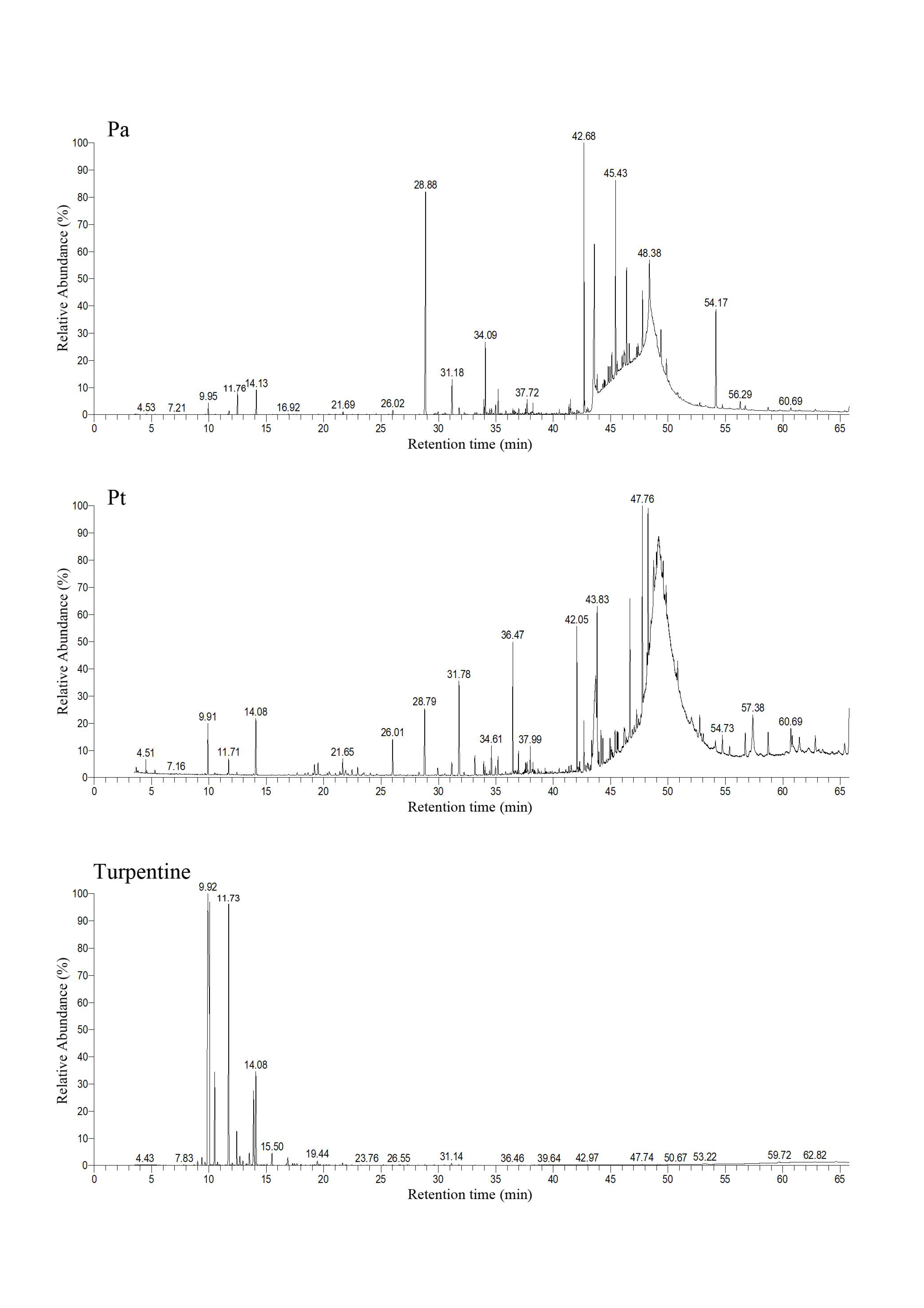
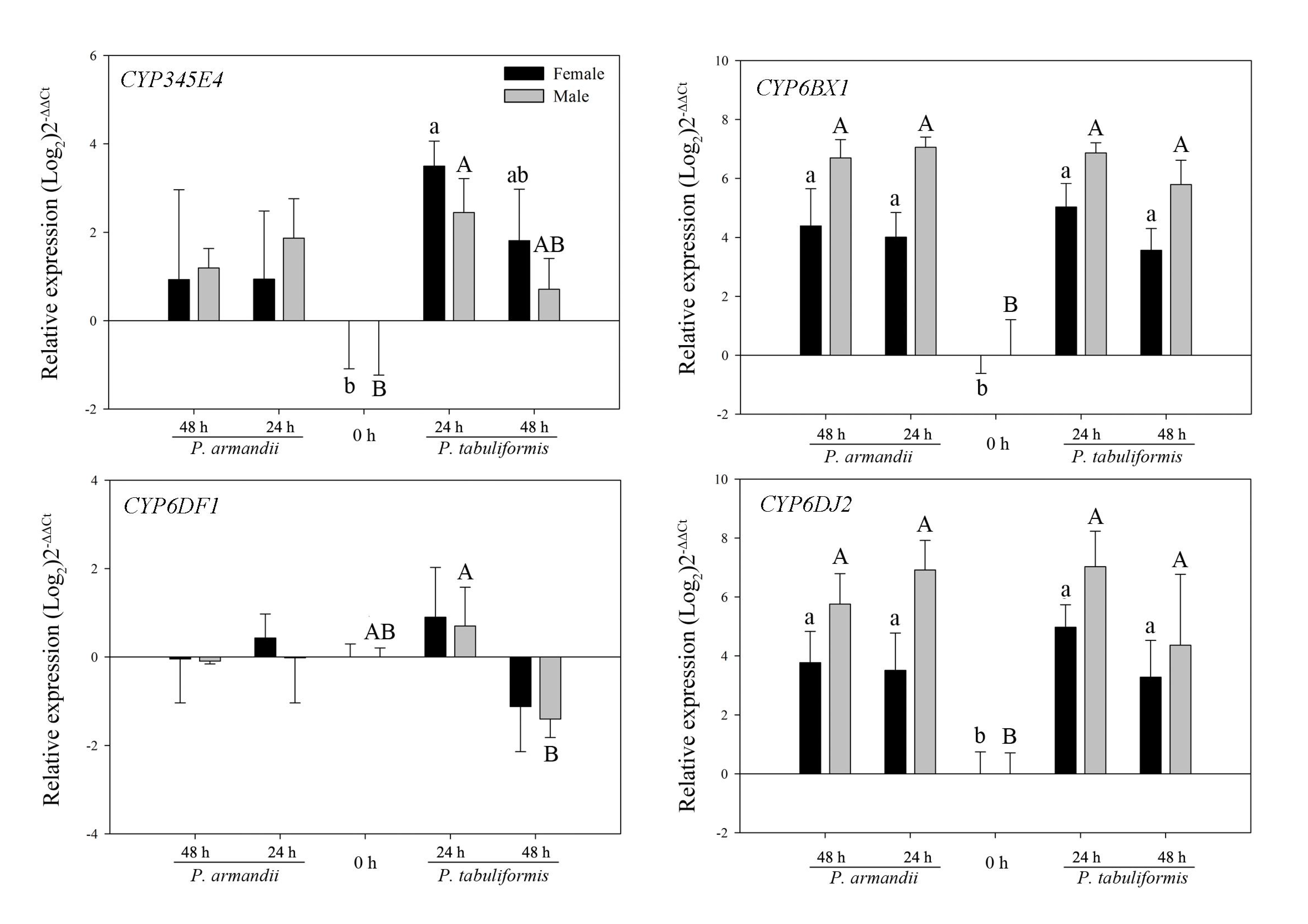
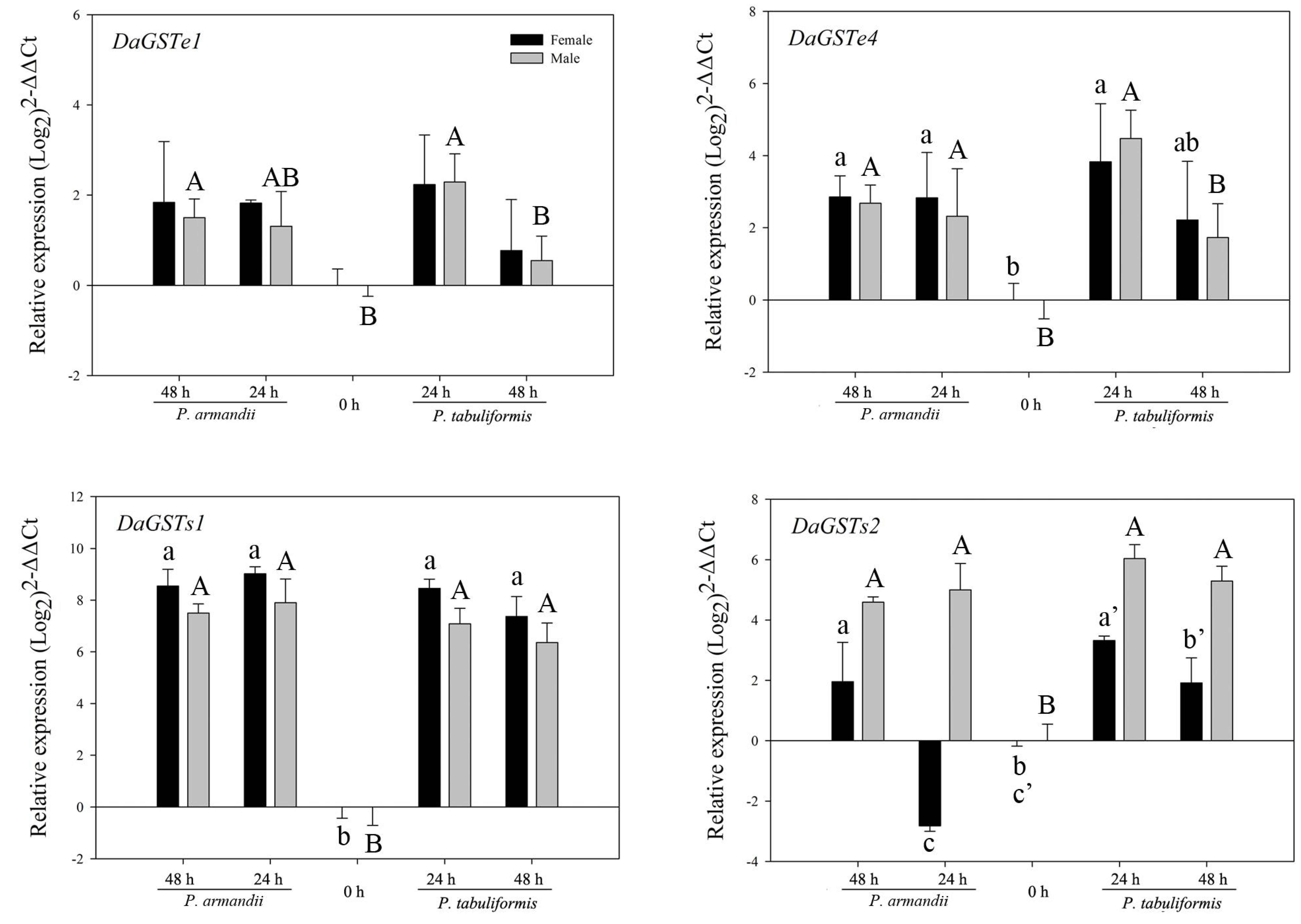

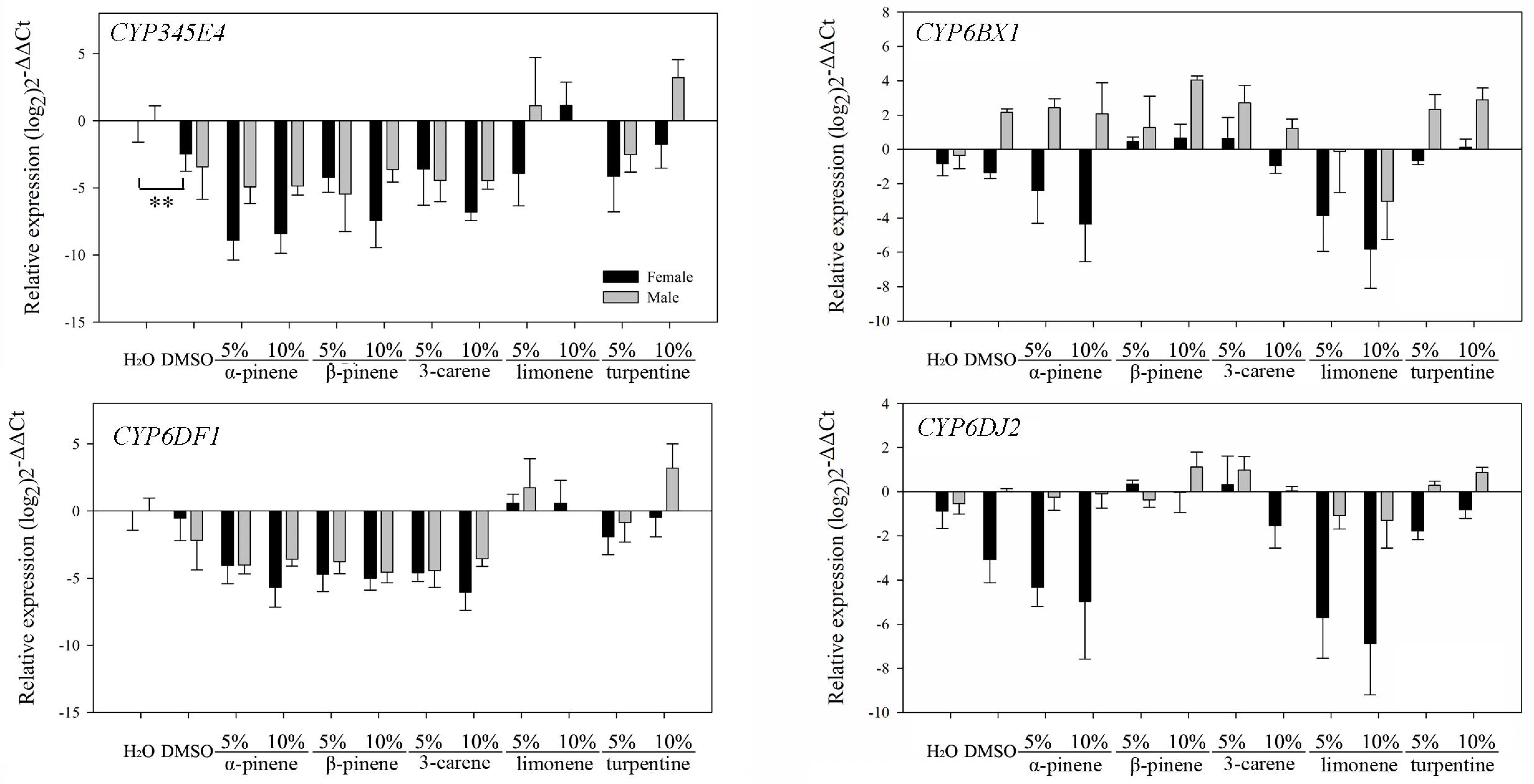
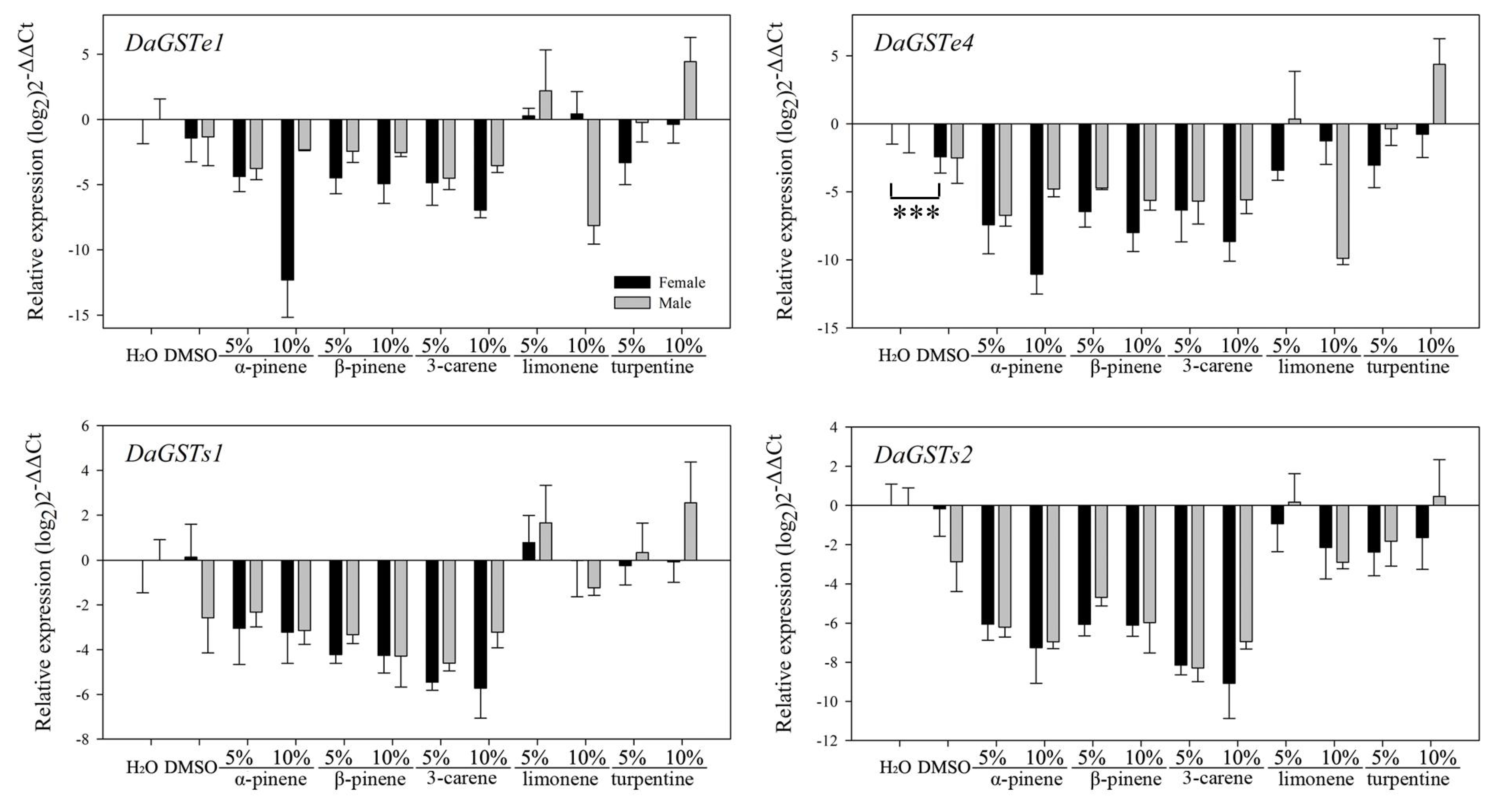

| Compound | Molecular Weight | Pa | Pt | Turpentine | |||
|---|---|---|---|---|---|---|---|
| RT (min) | RA (%) | RT (min) | RA (%) | RT (min) | RA (%) | ||
| α-pinene | 136 | 9.95 | 0.71 ± 0.22 | 9.91 | 1.87 ± 1.14 | 9.92 | 56.62 ± 2.35 |
| camphene | 136 | 10.55 | 0.04 ± 0.01 | 10.51 | 0.08 ± 0.05 | 10.50 | 5.20 ± 0.47 |
| β-pinene | 136 | 11.76 | 0.26 ± 0.08 | 11.71 | 0.76 ± 0.35 | 11.73 | 18.34 ± 1.16 |
| β-myrcene | 136 | 12.48 | 1.37 ± 0.42 | 12.44 | 0.15 ± 0.06 | 12.43 | 1.89 ± 0.04 |
| D-limonene | 136 | 14.13 | 1.67 ± 0.52 | 14.08 | 2.68 ± 0.97 | 14.08 | 11.73 ± 0.50 |
| trans-verbenol | 152 | 19.54 | 0.04 ± 0.01 | 19.51 | 1.34 ± 0.91 | ||
| bornyl acetate | 196 | 26.02 | 0.36 ± 0.09 | 26.01 | 2.05 ± 0.53 | ||
| longifolene | 204 | 31.18 | 2.72 ± 0.70 | 31.15 | 0.80 ± 0.19 | ||
| caryophyllene | 204 | 31.80 | 0.54 ± 0.15 | 31.97 | 5.98 ± 1.36 | ||
| humulene | 204 | 33.18 | 0.13 ± 0.04 | 33.17 | 1.04 ± 0.22 | ||
| germacrene D | 204 | 34.09 | 4.78 ± 1.32 | 34.09 | 0.37 ± 0.08 | ||
| Gene | Sex | df | Pa | Pt | ||
|---|---|---|---|---|---|---|
| F | p-Value | F | p-Value | |||
| CYP345E4 | ♀ | 2 | 0.342 | 0.723 | 9.645 | 0.013 |
| ♂ | 2 | 3.231 | 0.112 | 5.478 | 0.044 | |
| CYP6BX1 | ♀ | 2 | 20.240 | 0.002 | 38.246 | <0.001 |
| ♂ | 2 | 72.225 | <0.001 | 54.293 | <0.001 | |
| CYP6DF1 | ♀ | 2 | 0.463 | 0.650 | 3.834 | 0.085 |
| ♂ | 2 | 0.020 | 0.980 | 10.552 | 0.011 | |
| CYP6DJ2 | ♀ | 2 | 12.220 | 0.008 | 21.352 | 0.002 |
| ♂ | 2 | 47.810 | <0.001 | 14.624 | 0.005 | |
| DaGSTe1 | ♀ | 2 | 5.106 | 0.051 | 4.409 | 0.066 |
| ♂ | 2 | 7.311 | 0.025 | 17.312 | 0.003 | |
| DaGSTe4 | ♀ | 2 | 11.300 | 0.009 | 6.098 | 0.036 |
| ♂ | 2 | 8.392 | 0.018 | 25.823 | 0.001 | |
| DaGSTs1 | ♀ | 2 | 348.950 | <0.001 | 212.283 | <0.001 |
| ♂ | 2 | 121.334 | <0.001 | 96.182 | <0.001 | |
| DaGSTs2 | ♀ | 2 | 29.396 | 0.001 | 33.313 | 0.001 |
| ♂ | 2 | 63.084 | <0.001 | 128.045 | <0.001 | |
| DaCarE3 | ♀ | 2 | 11.536 | 0.009 | 11.718 | 0.008 |
| ♂ | 2 | 36.506 | <0.001 | 51.775 | <0.001 | |
| DaCarE4 | ♀ | 2 | 46.650 | <0.001 | 53.767 | <0.001 |
| ♂ | 2 | 60.536 | <0.001 | 140.578 | <0.001 | |
| Gene | Sex | Independent Sample t-Test * | df | (−)-α-Pinene | (−)-β-Pinene | (+)-3-Carene | Limonene | Turpentine | ||||||
|---|---|---|---|---|---|---|---|---|---|---|---|---|---|---|
| t | p-Value | F | p-Value | F | p-Value | F | p-Value | F | p-Value | F | p-Value | |||
| CYP345E4 | ♀ | 5.961 | 0.004 | 3 | 27.185 | <0.001 | 12.239 | 0.002 | 8.006 | 0.009 | 4.879 | 0.032 | 2.432 | 0.140 |
| ♂ | −0.855 | 0.441 | 3 | 6.963 | 0.013 | 3.917 | 0.054 | 5.303 | 0.026 | 2.508 | 0.162 | 10.012 | 0.004 | |
| CYP6DF1 | ♀ | 0.961 | 0.391 | 3 | 10.252 | 0.004 | 11.567 | 0.003 | 14.903 | 0.001 | 0.392 | 0.762 | 0.941 | 0.465 |
| ♂ | −1.060 | 0.349 | 3 | 6.223 | 0.017 | 6.844 | 0.013 | 5.959 | 0.019 | 3.372 | 0.104 | 5.660 | 0.022 | |
| CYP6BX1 | ♀ | 1.999 | 0.116 | 3 | 36.981 | <0.001 | 2.167 | 0.170 | 5.126 | 0.029 | 30.365 | <0.001 | 1.897 | 0.209 |
| ♂ | −0.900 | 0.419 | 3 | 1.463 | 0.296 | 1.098 | 0.404 | 1.512 | 0.284 | 7.713 | 0.010 | 1.402 | 0.311 | |
| CYP6DJ2 | ♀ | 2.671 | 0.056 | 3 | 13.315 | 0.002 | 2.620 | 0.123 | 3.670 | 0.063 | 60.936 | <0.001 | 4.630 | 0.037 |
| ♂ | 0.082 | 0.939 | 3 | 0.788 | 0.533 | 0.276 | 0.841 | 0.954 | 0.460 | 3.138 | 0.087 | 0.449 | 0.725 | |
| DaGSTe1 | ♀ | 1.945 | 0.124 | 3 | 22.199 | <0.001 | 6.418 | 0.016 | 11.909 | 0.003 | 0.844 | 0.507 | 2.254 | 0.159 |
| ♂ | −0.848 | 0.444 | 3 | 3.717 | 0.061 | 2.078 | 0.182 | 5.994 | 0.019 | 12.329 | 0.002 | 5.949 | 0.020 | |
| DaGSTe4 | ♀ | 19.274 | <0.001 | 3 | 28.401 | <0.001 | 23.347 | <0.001 | 16.017 | 0.001 | 3.632 | 0.064 | 2.564 | 0.128 |
| ♂ | −0.042 | 0.969 | 3 | 11.259 | 0.003 | 8.832 | 0.006 | 7.480 | 0.010 | 13.152 | 0.002 | 7.589 | 0.010 | |
| DaGSTs1 | ♀ | −0.584 | 0.591 | 3 | 4.662 | 0.036 | 14.691 | 0.001 | 20.552 | <0.001 | 0.202 | 0.892 | 0.049 | 0.985 |
| ♂ | 0.088 | 0.934 | 3 | 5.637 | 0.023 | 7.591 | 0.010 | 11.543 | 0.003 | 6.311 | 0.017 | 6.383 | 0.016 | |
| DaGSTs2 | ♀ | 0.643 | 0.555 | 3 | 24.539 | <0.001 | 37.575 | <0.001 | 43.895 | <0.001 | 1.463 | 0.296 | 2.180 | 0.168 |
| ♂ | 1.701 | 0.164 | 3 | 35.148 | <0.001 | 14.041 | 0.001 | 45.974 | <0.001 | 6.591 | 0.015 | 3.519 | 0.069 | |
| DaCarE3 | ♀ | 0.817 | 0.460 | 3 | 5.661 | 0.022 | 59.159 | <0.001 | 35.633 | <0.001 | 1.871 | 0.213 | 0.221 | 0.879 |
| ♂ | −0.463 | 0.668 | 3 | 23.826 | <0.001 | 39.519 | <0.001 | 15.217 | 0.001 | 8.075 | 0.008 | 6.862 | 0.013 | |
| DaCarE4 | ♀ | 0.686 | 0.530 | 3 | 8.508 | 0.007 | 23.794 | <0.001 | 26.736 | <0.001 | 0.231 | 0.872 | 0.926 | 0.471 |
| ♂ | 2.293 | 0.084 | 3 | 10.537 | 0.004 | 12.757 | 0.002 | 14.858 | 0.001 | 5.243 | 0.027 | 4.358 | 0.043 | |
Publisher’s Note: MDPI stays neutral with regard to jurisdictional claims in published maps and institutional affiliations. |
© 2021 by the authors. Licensee MDPI, Basel, Switzerland. This article is an open access article distributed under the terms and conditions of the Creative Commons Attribution (CC BY) license (https://creativecommons.org/licenses/by/4.0/).
Share and Cite
Dai, L.; Gao, H.; Chen, H. Expression Levels of Detoxification Enzyme Genes from Dendroctonus armandi (Coleoptera: Curculionidae) Fed on a Solid Diet Containing Pine Phloem and Terpenoids. Insects 2021, 12, 926. https://doi.org/10.3390/insects12100926
Dai L, Gao H, Chen H. Expression Levels of Detoxification Enzyme Genes from Dendroctonus armandi (Coleoptera: Curculionidae) Fed on a Solid Diet Containing Pine Phloem and Terpenoids. Insects. 2021; 12(10):926. https://doi.org/10.3390/insects12100926
Chicago/Turabian StyleDai, Lulu, Haiming Gao, and Hui Chen. 2021. "Expression Levels of Detoxification Enzyme Genes from Dendroctonus armandi (Coleoptera: Curculionidae) Fed on a Solid Diet Containing Pine Phloem and Terpenoids" Insects 12, no. 10: 926. https://doi.org/10.3390/insects12100926
APA StyleDai, L., Gao, H., & Chen, H. (2021). Expression Levels of Detoxification Enzyme Genes from Dendroctonus armandi (Coleoptera: Curculionidae) Fed on a Solid Diet Containing Pine Phloem and Terpenoids. Insects, 12(10), 926. https://doi.org/10.3390/insects12100926






